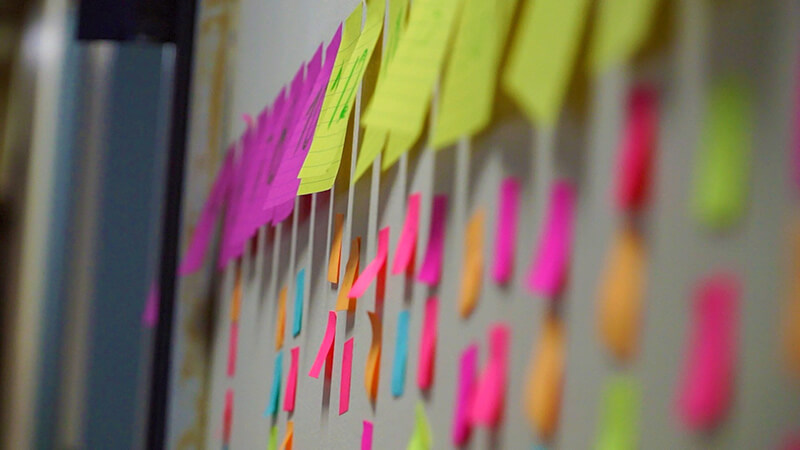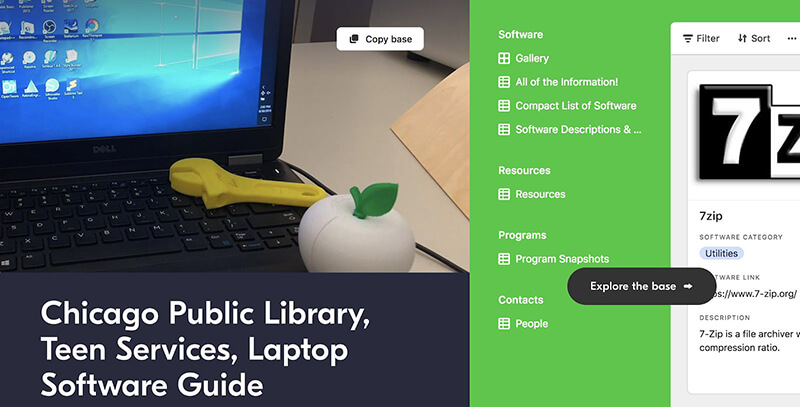Case Example
Professional Learning Supports for Flexible and Responsive Drop-in Programming at YOUmedia
Jeremy Dunn - Chicago Public Library
This resource highlights the professional learning approaches of Chicago Public Library’s Teen Services division. They focus on providing flexible, ongoing avenues for youth educators across their branches to advance pedagogy around interest-driven, drop-in models of digital learning.

Providing engaging programs for teens in the context of a large, complex system such as Chicago Public Library (CPL) sometimes feels like trying to master the complexities and problems of space travel. At the root of our strategic structures for professional learning is effective communication and practical, hands-on learning. If we can consistently provide the structures and formats for peer-to-peer sharing as well as flexible and meaningful real-world learning, we know that our staff will grow and our engagement with teens will thrive.
Our mission at CPL is to keep the teens coming back; they keep coming back because they have found value in the relationships they develop and in the resources they discover for their own personal learning journeys. One of our key strategies to fulfill this mission is to effectively prepare our staff to meet a range of needs so that teens who visit our libraries have positive and affirming experiences.
How do we nurture and sustain effective professional development practices so we can succeed? How do we assemble the diverse set of resources at our disposal to create the right stuff so that more teens who come to the library have great experiences?
As a first step, we recognize the complexity of our system. Our library serves a large and diverse city with varying community compositions as well as a range of library facilities. In addition, teen interests and needs are not monolithic, requiring staff to develop the right relationships and responses to the teens who are in front of them. Finally, staff bring varied experiences, skill sets, and personal styles to their work. Even in light of “best practice,” we recognize that staff must develop facilitation styles that work for them and that also align to teen developmental needs.

Our Approach to Professional Learning
The professional development that CPL provides for teen library staff is based on supporting them as educators to develop responsive and flexible drop-in programming. The administrative team supports this work by providing resources — materials, partners, program opportunities, etc. — as well as structured learning opportunities that provide a range of activities through a variety of activities and formats. As outlined in the logic model below, our approach first emphasizes the diversity of youth needs; second, it recognizes that staff development goals are individualized and reflect nationally-recognized youth development standards. Ultimately, our aim is to support staff to independently develop and grow their program implementation so activities are successful for their communities and are aligned to our mission of nurturing learning for our teen patrons.
Logic Model for YOUmedia Professional Learning

Professional Learning in Action at CPL
Development of programs within YOUmedia and the Chicago Public Library can take a number of forms. These are just a few examples of how programs develop within the Teen Services community.
Formal Hands-on Training and Traveling Kits Lead to New Program Opportunities
After successfully piloting sewing machine usage at CPL’s downtown YOUmedia location, teen librarian Marshall offered hands-on sewing machine certification trainings to teen library staff at large. After the training, traveling sewing machine kits were made available to teen staff to check out to use for programs at their branch locations. Maggie, a teen librarian at the Albany Park branch, used these new skills and resources to develop programs that connected directly with here teen audience’s interests. Teens at Albany Park love geek and anime culture, so Maggie helped teens at the branch to learn how to design and construct cosplay costumes to wear to conventions. These teens also did not have easy access to new clothes so they also learned how to upcycle old items and thrift store clothing, a program extension that helped them connect with their community in new way. At the West Belmont library branch, adults and teens need to use the same workshop space due to physical constraints. When teen library associate, Karen, discovered that adults were equally interested in the sewing classes that she had introduced to her teen patrons, she redesigned the workshop to be multi-generational so she could involve both demographics in a space-challenged environment. As we continue to provide training that builds staff knowledge and provides access to new technology, we also give staff the freedom and power to use newfound knowledge and in novel ways that are focused on their community of learners.
Staff Share-outs Igniting New Programs
Teen library associate Ade, recognizing a need at his branch in West Englewood, developed a community program called Barbershop @ the Library. Local barbers offered free haircuts to teens and also a safe space to talk about issues that these teens were facing in their lives and in the community. But it wasn’t until a local TV station created a spotlight of his barbershop program that our central department learned about his innovative approach. In our large program universe — stretched across 77 neighborhood communities across 234 square miles — not all staff readily share their program successes, another factor to navigate in facilitating effective staff-to-staff communication in a large constellation of programs.
As we learned of Ade’s programmatic achievement — and as he was being recruited as a feature for Chicago’s morning show Windy City LIVE — we asked him to share out with staff during the next “cluster meeting,” our monthly Teen Services library staff meeting that provides a forum and a community of practice for 80+ positions at CPL that provide teen programs. A new teen associate, Armena, who worked in a different community in Chicago, learned about Ade’s barbershop program and was inspired. It didn’t happen immediately, but within 18 months, she had adapted the program for her neighborhood library on the west side of Chicago, renaming the program Fades 4 Days.
It’s easy to take a good idea and replicate it if it meets your needs and inspires you. We provide those structures and channels for good ideas to find the next audience that needs them so we can continue to accomplish our mission.
Staff Shadowing and Consultations as Key Tools for Program Improvement
New teen staff are given the opportunity to shadow existing staff members at established branches, with shadowing locations selected in order to give staff a wide breadth of experience. Because each branch is different, new staff members need to experience the differences while also recognizing the similarities in services between locations.
After the initial on-boarding, staff are then encouraged to follow up with each other through cluster meetings and through individual consultations to refine their program ideas. For example, the Dunning and West Belmont branch are in fairly close proximity and have an overlapping service area. The teen library associates from these branches regularly conduct outreach together and meet to discuss program ideas and best practices that can serve their communities.
Staff communities that are geographically far apart also meet with each other to learn new skills and refine program ideas. Staff from the Harold Washington Library Center and the Thurgood Marshall branch would discuss programming around podcasting and AV production often. Even though their communities were very different, the teen interest was the same and the ability to consult with each other within the CPL Teen Services network allowed the programs in both communities to evolve.
Accessible Supports for Professional Development
In order to support staff who are at varying levels of comfort and knowledge with digital media tools, Teen Services staff have developed new resource guides for our software offerings. While ideally we would want to provide hands-on training for staff on all software that is available for teens to use, we know that is beyond our institutional capacity. However, we can provide guides and resources on all of the software so staff can familiarize themselves with software offered to teens.

One example of this is our software guide that we developed to support the rollout of new laptops for teen programs. The guide is designed to provide multiple access points to allow staff to use it in a variety of ways to support their own learning so they can build new programs that will keep teens coming back again and again.
As our program continues to grow in size and evolve in form or content, we anticipate that new support structures may develop and lead to even more effective staff performance and institutional responsiveness to youth needs. But one thing we don’t plan to change is putting the learner at the center of all that we do. Program administrators will continue to leverage effective communication among staff as a key to professional development so that program staff are fueled by both inspiration from their peers and effective, practical training offered in flexible formats.